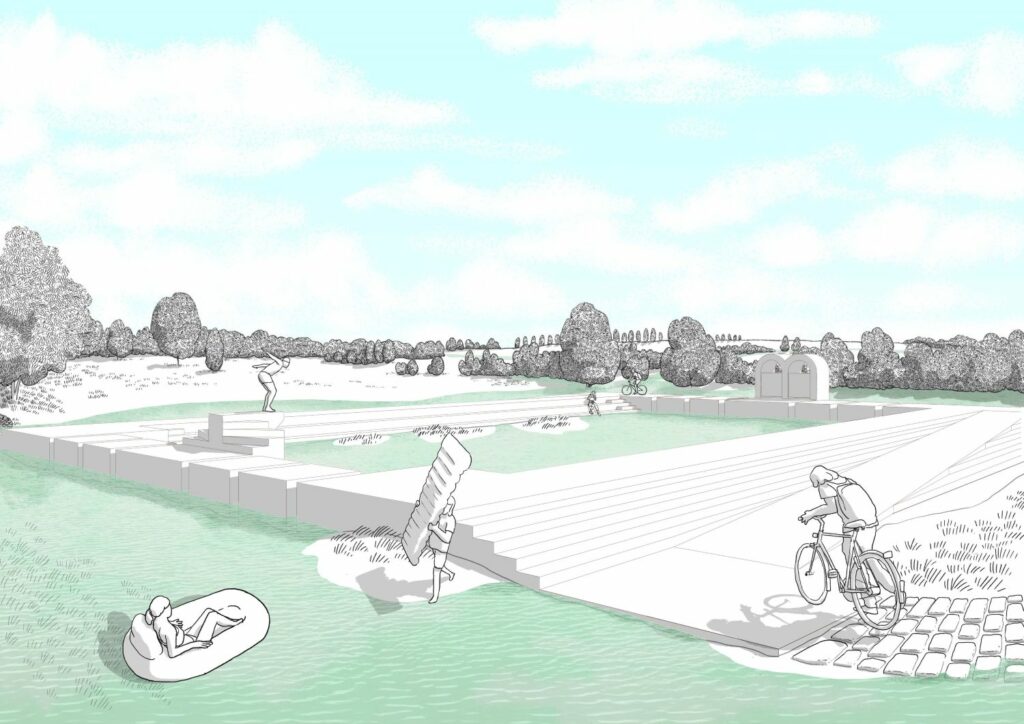Graduation project, Grands sentiers with Anne Bossé + Petra Marguc, Ensa Nantes, 2024
The Grands sentiers led by Anne Bossé, invites you to explore the area on foot, by walking. This action is as much a manifesto as it is a tool for apprehending spaces, enabling us to adopt a posture at the scale of the body in movement. With a strong focus on architectural research on Nantes, the project aims to create a major metropolitan trail by the end of its fourth and final edition in 2024. More information is available in the dedicated Hypothèse booklet https://gdsentiers.hypotheses.org/which compiles the genesis and approach of each project developed, including the Parlement de Tougas created in the same studio.
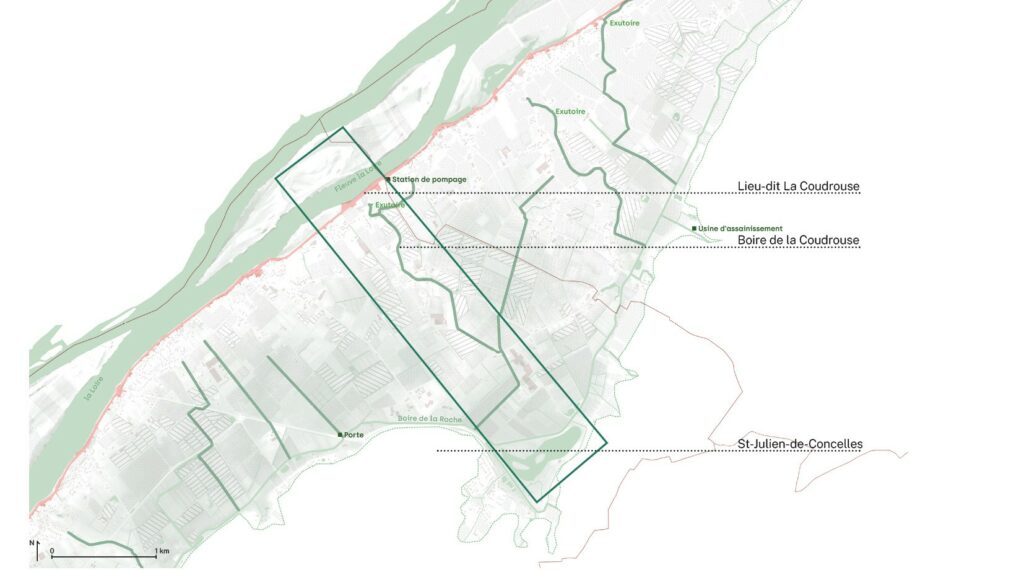
La Reconnexion du Boire de la Coudrouse is a forward-looking territorial project to reconnect one of the former boires de Loire in the heart of the Vallée de la Divatte with the main waterway. The Vallée de la Divatte is described in greater detail in the territorial analysis available by following this link. This backwater stretches from the opening of the Divatte levee at La Coudrouse to the town of St-Julien-de-Concelles, the commune's main town. Rushing waters of the Loire redraw the course of the river, spreading out and resedimenting the Divatte Valley. The return of ingenious species such as the beaver has permanently transformed the course of the river.

These species dig, dam and maintain their wetlands, creating a multitude of situations, meeting points and land-use conflicts along the course of the river. These situations include:
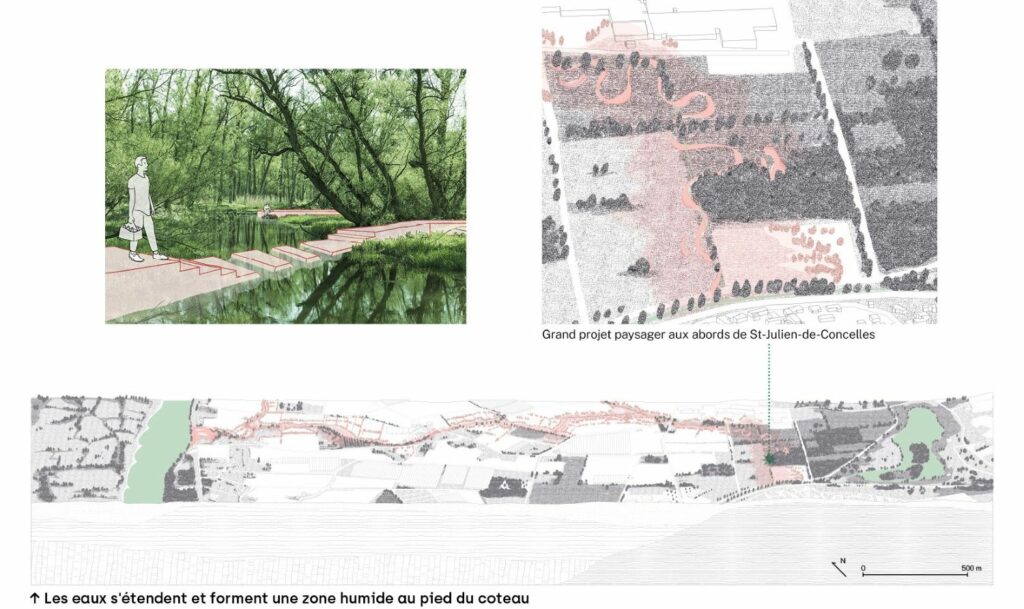
On the outskirts of St-Julien-de-Concelles, at the confluence with the Boire de la Roche at the bottom of the hillside, water extends into meadows and sports fields along the Chêne lake. This return of water would encourage the extension of the wetland from the pond, opening up possibilities for a major landscaping project.
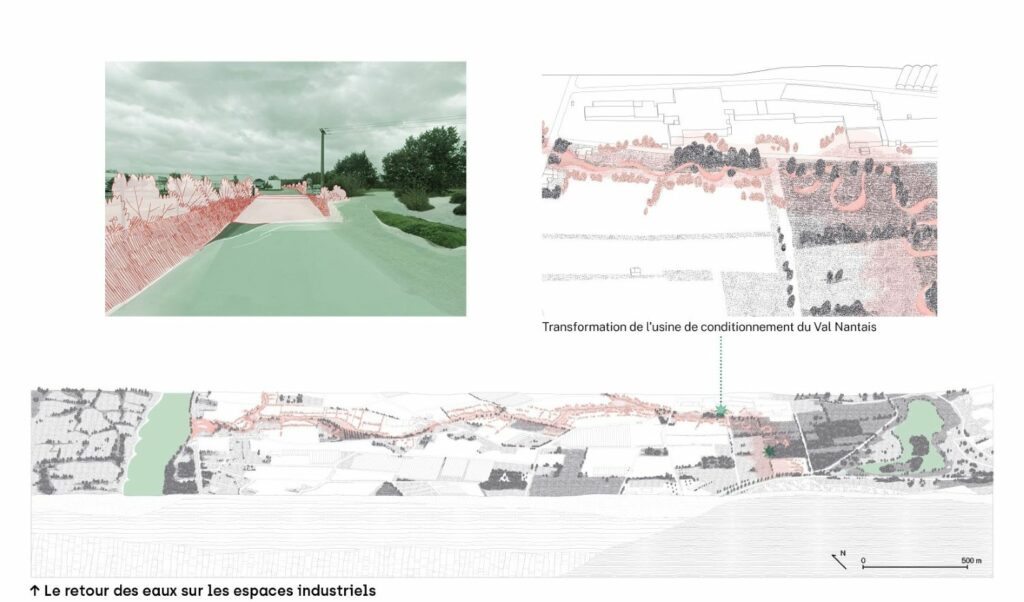
Further upstream, the gradual rerouting of water from its drainage area could clash with the Val Nantais packaging plant. This 75,000 square meter industrial facility employs 280 people and generates annual sales of €22 million. The single-storey buildings could occasionally be affected by seasonal floodwaters. Consideration will therefore need to be given to relocating or insulating this key infrastructure for market garden production. Buildings could also be converted so that they can occasionally be flooded.
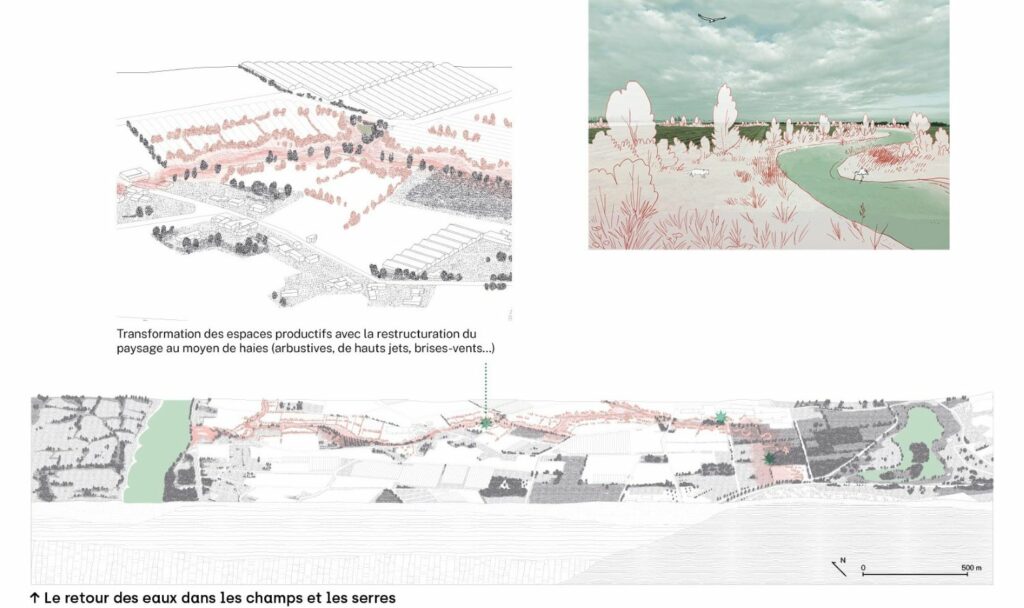
In the same way, the re-medandering of water encounters agricultural production areas, fields, greenhouses, plastic chapels, etc. These areas will have to adapt by proposing practices that allow this cohabitation with uncontrolled water. The use of phytosanitary products will be greatly reduced, market garden beds will be reoriented to prevent run-off and soil erosion, and greenhouses will not be able to be maintained all year round. The restructuring of the landscape includes various hedges that act as windbreaks, barriers to run-off, water absorption and reserves for natural predators of species that can cause damage to crops. These hedges, which are essential to biodiversity and characteristic of market garden areas in wetlands, were gradually reshaped and consolidated until they disappeared at the end of the 20th century to facilitate the use of industrial production tools. The return of the hedges is bringing back a multitude of fragile or lost environments.
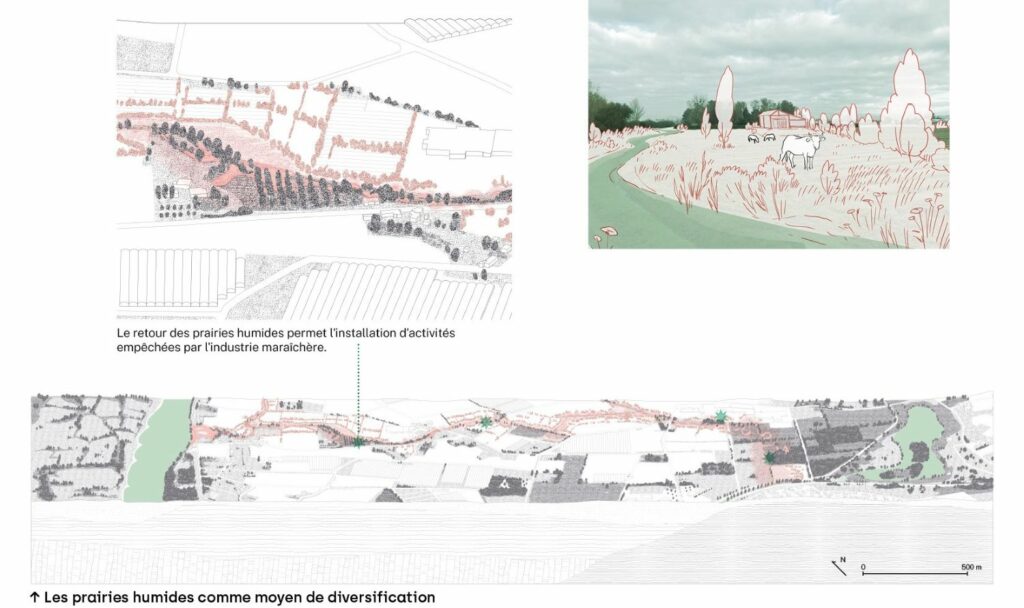
This restructuring of landscapes and farming practices will provide an opportunity to set up young farms whose practices are compatible with areas less standardised by water drainage. The return of wet meadows as a common feature, grazed and maintained by large cattle, would open up the possibility of an activity within the drinking area itself. This new livestock activity, compatible with wetlands environnement, could be set up in the former industrial market-garden infrastructures. We can imagine proposals for floodable sheds or raised mounds. This type of livestock farming is compatible with relatively high water levels and maintains the meadows, which are rich in habitats.
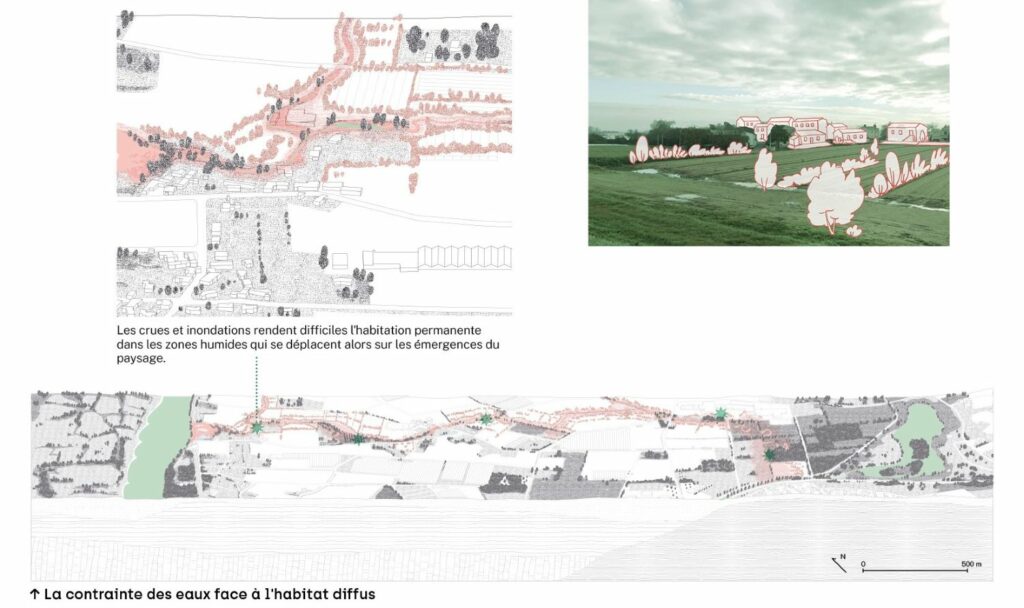
The majority of homes in the valley have been built on emergences in the landscape identified during flooding. These emergences, localities and villages will be densified by displaced dwellings and activities. The heart of the market town will re-form in these dense areas. Small shops and craft activities that had previously disappeared in these dispersed settlements are being redeployed.
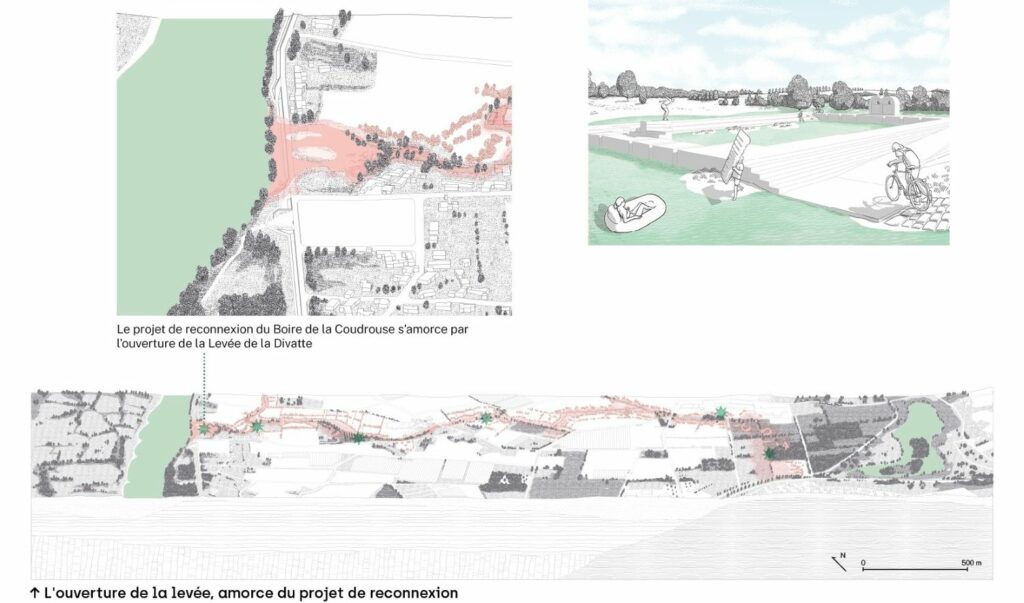
At La Coudrouse, 200 linear metres of the riverbank will be rehabilitated as part of the overall project to reconnect the Boire de la Coudrouse with the waters of the Loire.
This redevelopment involves dismantling a dyke, as well as changing people's attitudes to flooding.
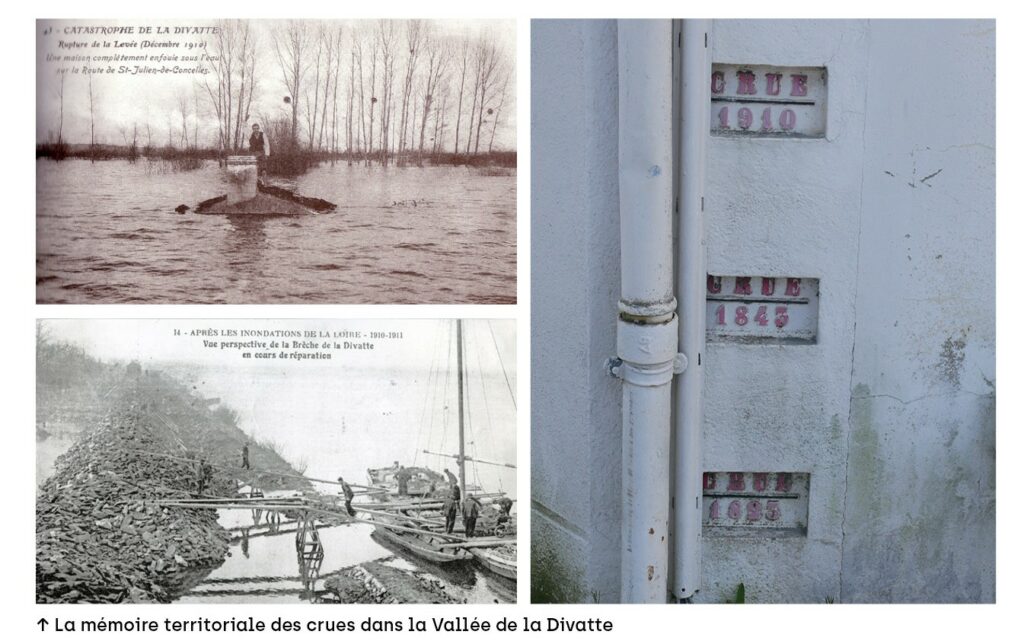
In 1856, 1857 and 1910, successive floods breached the Divatte levee and rushed in. Flooding was slow downstream of Blois, but the embankment increased the danger of submersion by causing a violent wave of flooding in the event of a breach. Even today, floods are still perceived as dangerous, despite the fact that some of the major riverbeds are inhabited and cultivated in areas that are regularly flooded. Reopening the boire therefore also means reinventing territorial memory and rebuilding our relationship with flood waters.
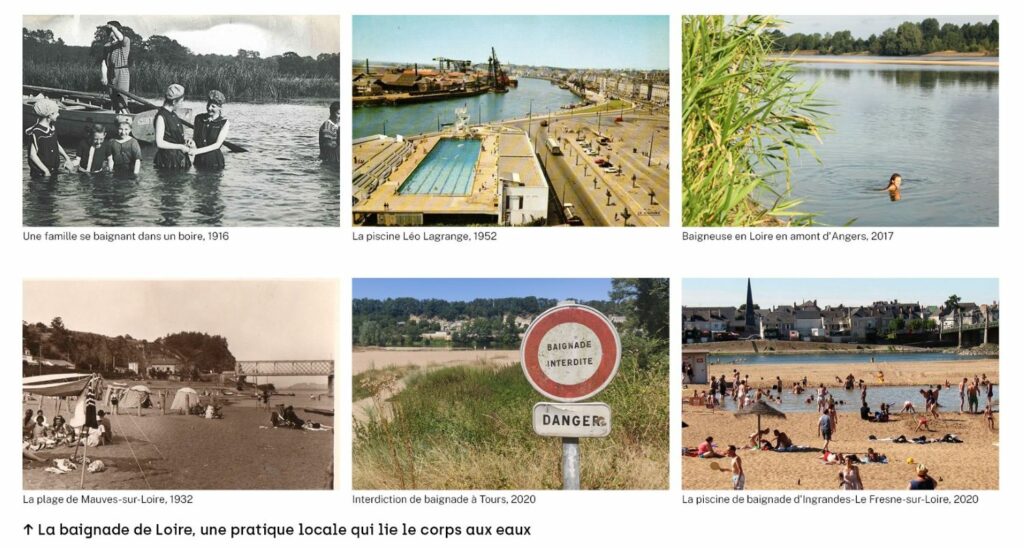
This change in the way people relate to floodwaters hinges on the possibility of a revival of bathing in the Loire in the Divatte Valley. Swimming in the Loire was banned in 1970. A whole culture of local leisure activities was thrown out. Throughout the 20th th century, the Loire and its major river bed were popular holiday destinations for the inhabitants of the region. Numerous public and private bathing establishments sprang up, beaches were developed, etc. Proposing the return of this practice is not just a local leisure project, it also means encouraging a different relationship with bathing areas, different from mass tourism on the seashore or controlled waters in chlorinated swimming pools. It's about immersing your body in an environment that is not 100% controlled by humans, shared with other living beings.
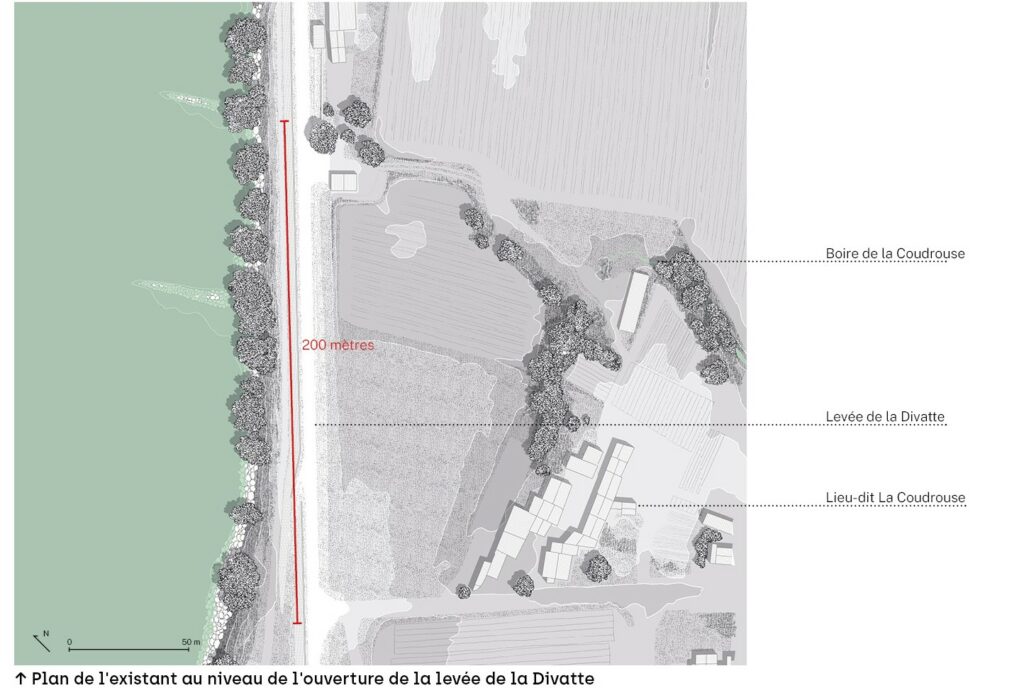
The project to reconnect the Boire de la Coudrouse therefore begins with this project to open up 200 linear metres of the Levée de la Divatte. This opening is emblematic of the project and should offer a transformed relationship with the waters of the river. Opening up the Divatte Levee means, first and foremost :
1- The removal of the 640 cubic meters of stone rubble from the Mauves-sur-Loire quarry that form the perimeter wall and the low wall, as well as the 360 cubic meters of asphalt from the departmental road overhanging the levee. This raw material will be reinvested in the project to reconnect the river.
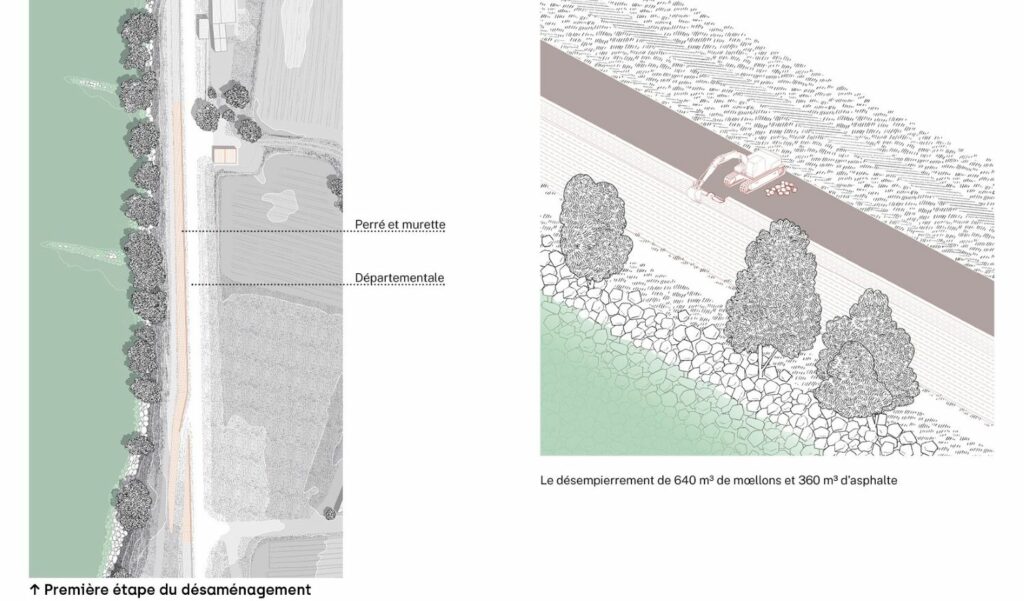
2- The second stage involves removing the 6650 cubic meters of clay and sandy soil that make up the levee. This soil was taken from the banks of the river or from the existing Loire beaches along the valley. This volume of heterogeneous soil will be used to reshape the temporary banks and add sediment to the river.
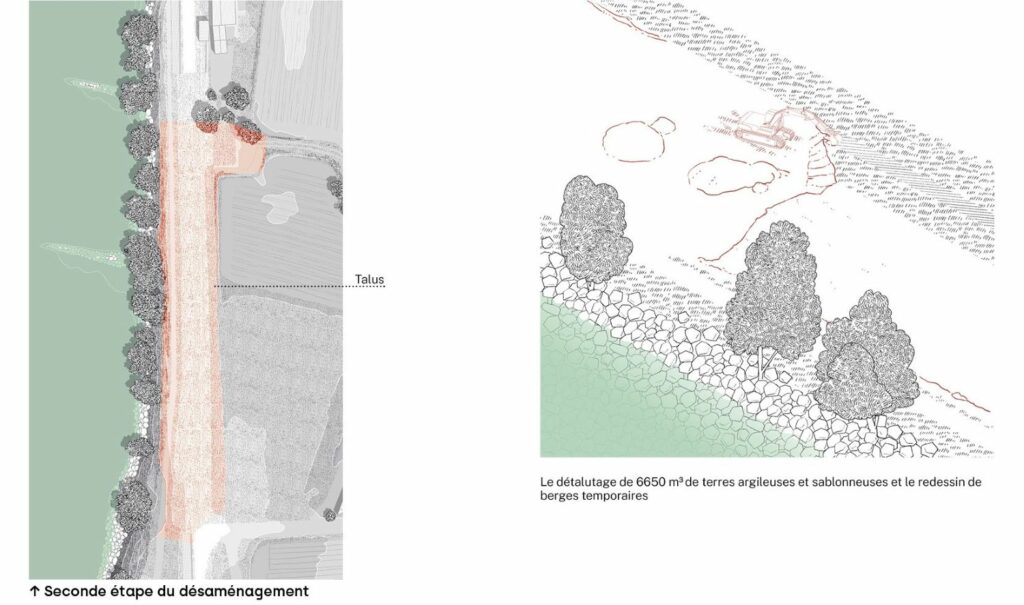
3- The third stage in the redevelopment of the Divatte Levee is the removal of the 9,600 cubic meters of rip-rap used to maintain the banks of the main channel and to protect the levee from scouring. Scouring is the erosion of the land on which the dyke is built. As the bed of the Loire was dug up to collect sand for market gardening and construction throughout the second half of the 20th th century, water levels dropped, threatening the foundations of the levee. This reinforcement was installed to prevent this phenomenon from threatening the coherence of the embankment system. With the opening of the levee, these rocks can be partially dismantled. The rip-rap along the bank will be maintained to prevent erosion downstream of the opening.
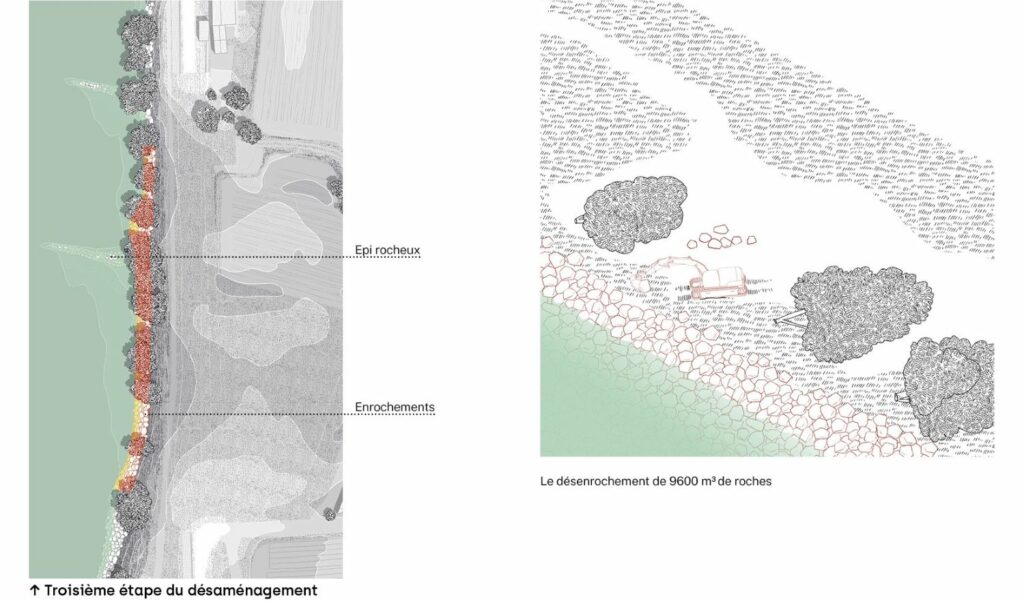
4- With the complete opening up of the 200 linear meters of the Levée, the water of the Loire can once again flow into the Boire de la Coudrouse. It gradually reshuffles the banks and the sediment deposited there, forming sandbanks, riverbanks, pools of water and wet meadows. To protect the areas of the dyked valley upstream and downstream of the opening, levee extensions using ramps are created from the reclaimed material.
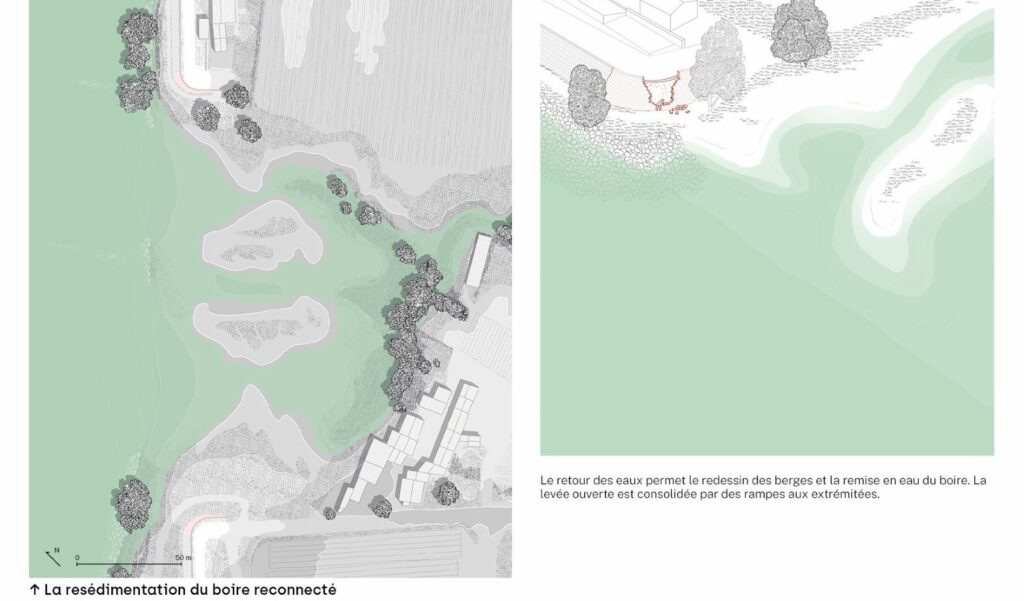
5- The Coudrouse swimming pool is based on the newly-formed sandbanks and water features. Constructed from around 600 m3 of rubble stone and masonry boulders, the proposal takes the form of a 40 by 20 metre swimming pool with steps, for a total structure of 50 by 40 metres. It includes a pool, two cabins and a diving board. All of this is accessible thanks to the steps and ramps on its sides. Gaps to the north and south allow the water, sediment, fauna and flora of the Loire to flow into the pool. The term ‘piscine’ here refers back to its Latin origins, meaning both the communal pool in Roman thermal baths and the fish and shellfish pond built near villas for aquaponics. The Coudrouse swimming pool is therefore a pool whose use depends on the Loire waters that fill it.
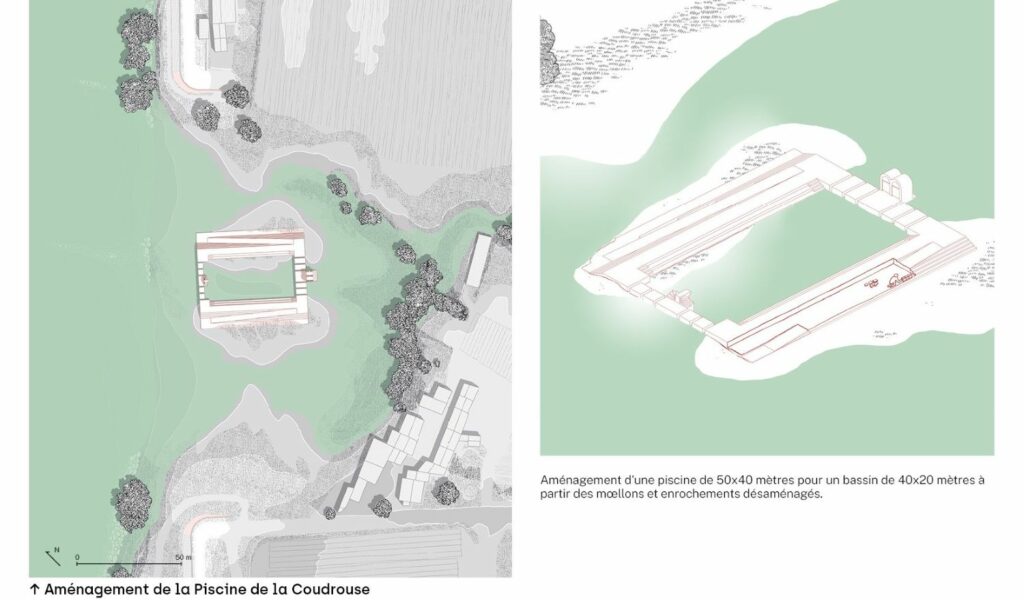
6- The Coudrouse swimming pool is located in an area crossed daily by both local and distant populations. The passage of the Loire à Vélo, a famous cycle route, and its facilities have encouraged the return of pedestrians and cyclists to peri-urban and rural areas dominated by cars. The redevelopment of 200 meters of the Levée de la Divatte supports these new ‘old’ practices, while maintaining the crossing of the river via the ford. A ford is a space where you can cross without totally immersing your body. Here, it takes the form of paving over suitable spaces along the sandbanks. This paving needs to be redesigned according to sedimentary movements.

This crossing is subject to water levels and means that you potentially have to put your foot down, take off your shoes and push your bike to reach the pool, then cross again to reach the opposite bank. The swimming architecture is used to invite people to immerse themselves in water that would usually be perceived as too dangerous (current, unstable bottom, flora and fauna). In the same way as river bathing, the architecture here invites visitors to come and enjoy the first warm days of spring. Cabins at the southern end of the pool facilitate and encourage swimming by offering a form of intimacy in the heart of the river. Steps at the centre of the pool are wide enough for people to lay down and enjoy the sun. The diving board to the north invites you to dive in.
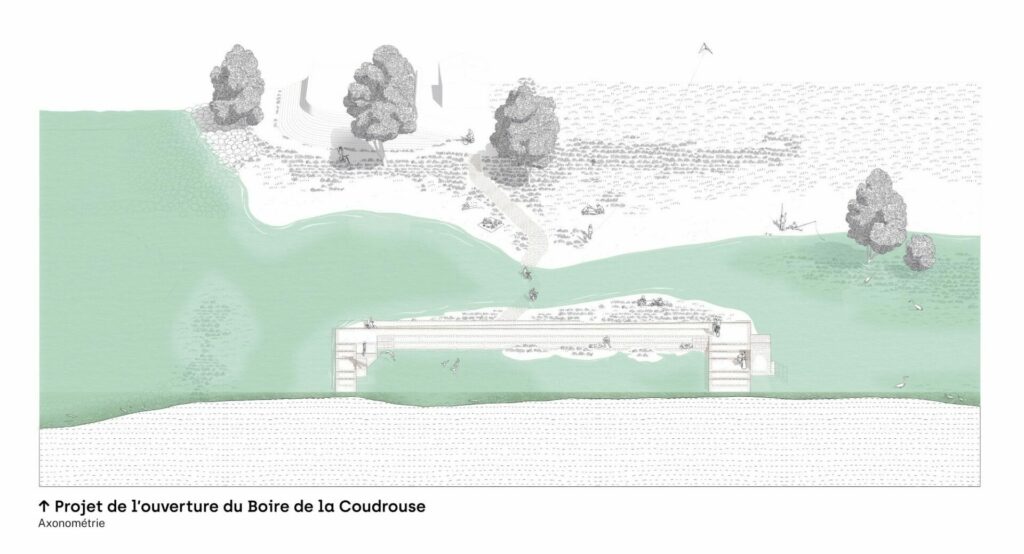
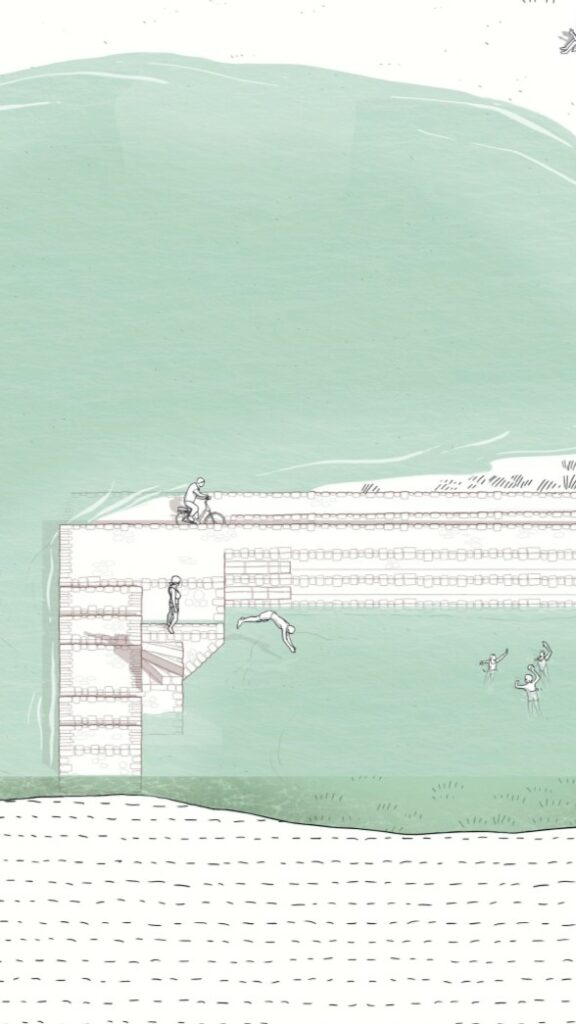
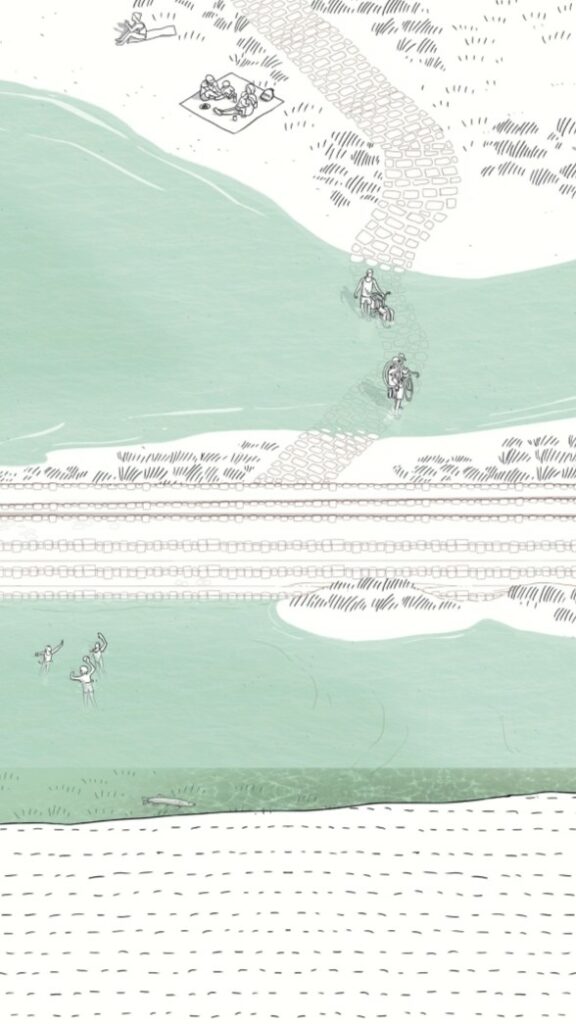
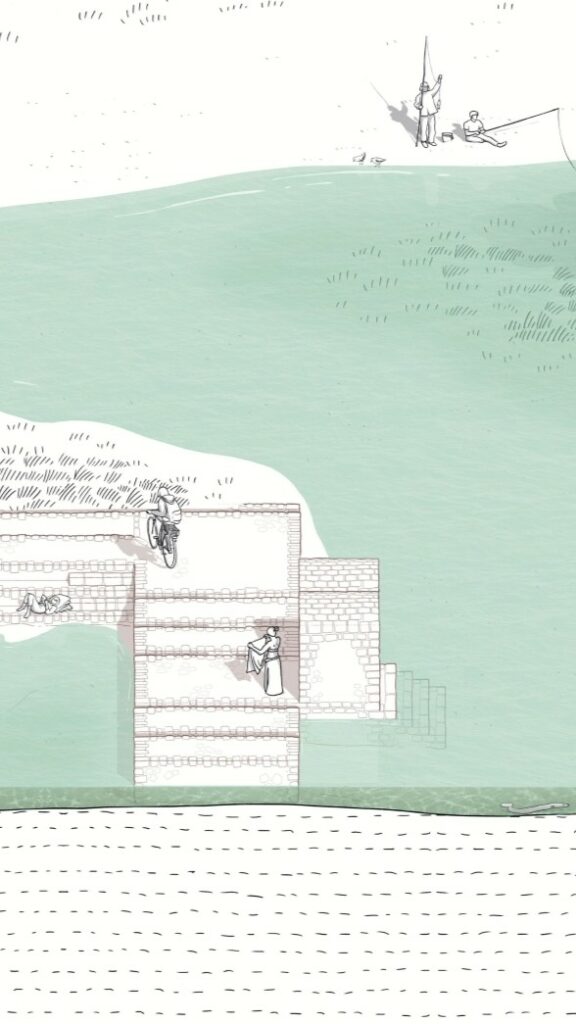
This bathing architecture also offers a striking spectacle during winter floods. The main body of the pool is now isolated in the centre of the boire. Water sometimes swallows up the steps, leaving only the diving board and cabins to surface like strange sculptures acting as flood markers. It is no longer possible to cross here and you will have to follow the course of the flooded boire to reach another crossing further downstream.
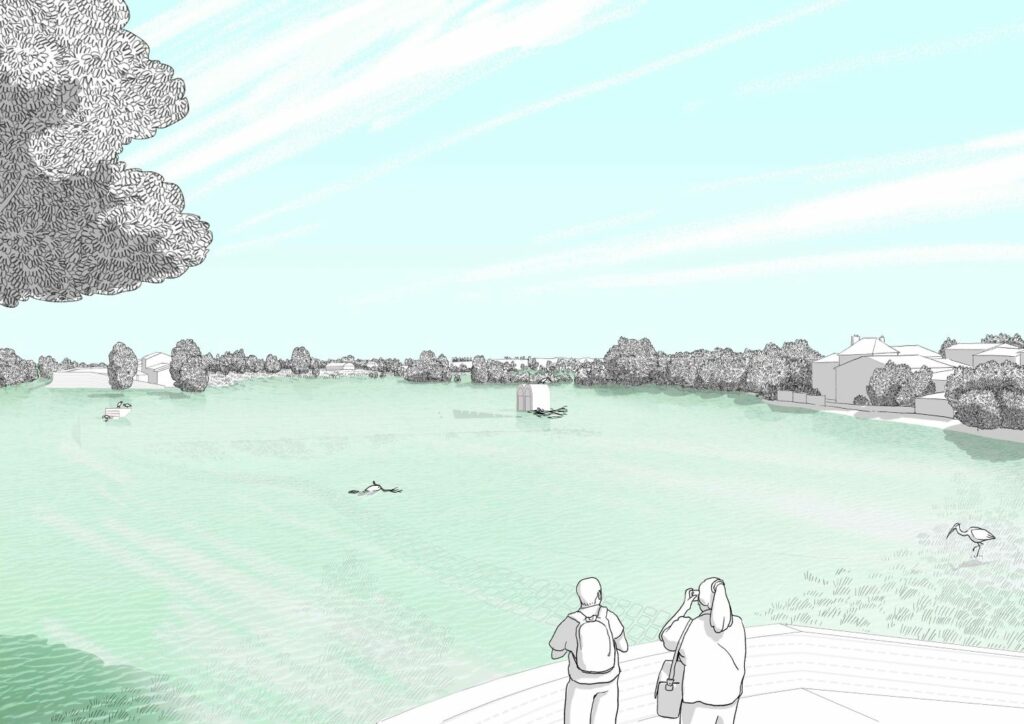
Similarly, at the height of summer and with heatwaves expected to become more and more frequent, the swimming pool and the ford, which are completely dry, live at the same rhythm as the Loire, placing them directly in line with its banks.
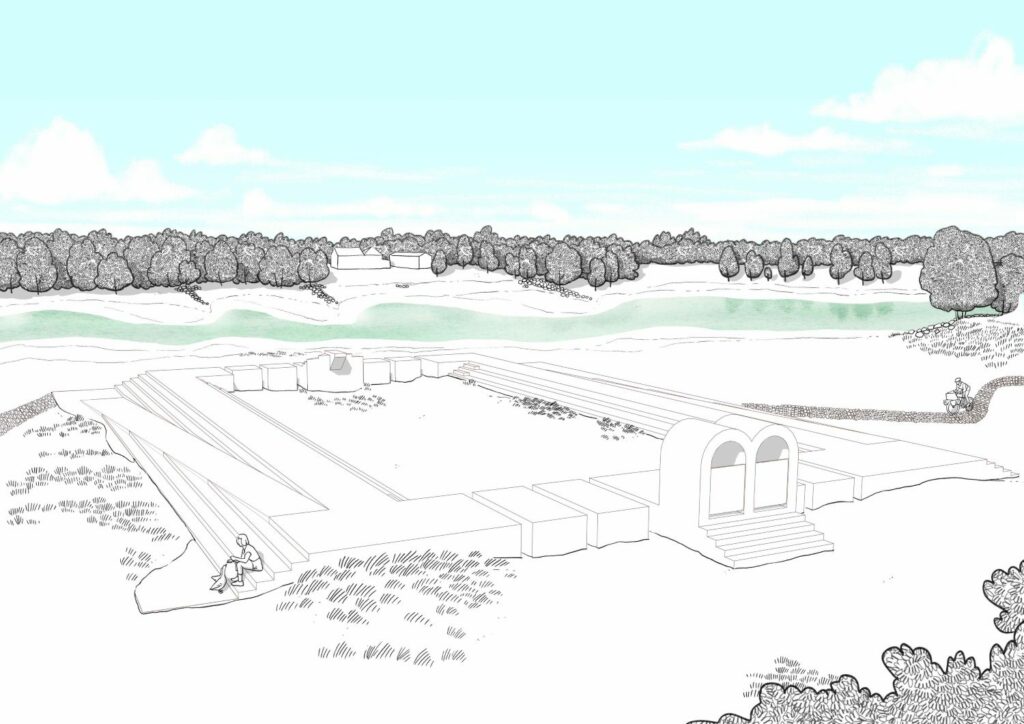
The project to reconnect the Boire de la Coudrouse redefines the relationship we have with the submergence of soil and structures by uncontrolled water, and proposes, in contrast to the project of controlling and draining the water, a project of habituation and adaptation. The opening of the Levée de la Divatte, with its swimming pool and ford, is the starting point for this reconnection of the Boire, as it allows the waters of the Loire to enter the valley, but also because it makes it possible to envisage this return of flooding not as a catastrophe, but rather as a necessary condition for life in the valley.
